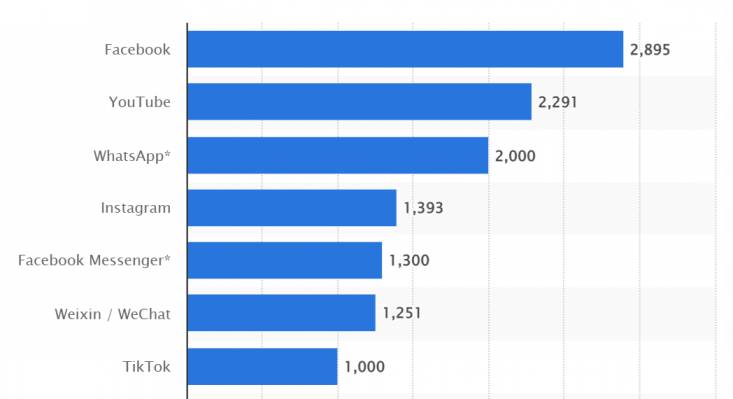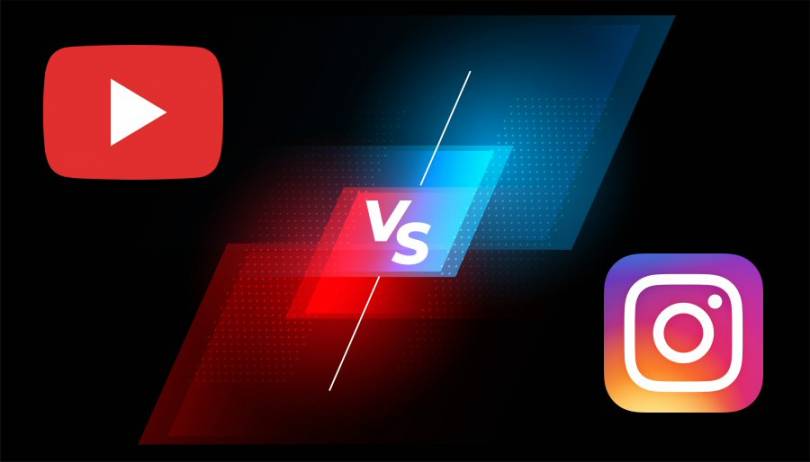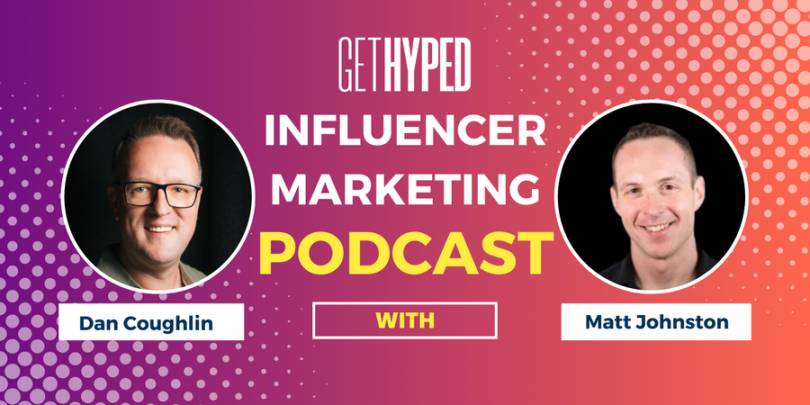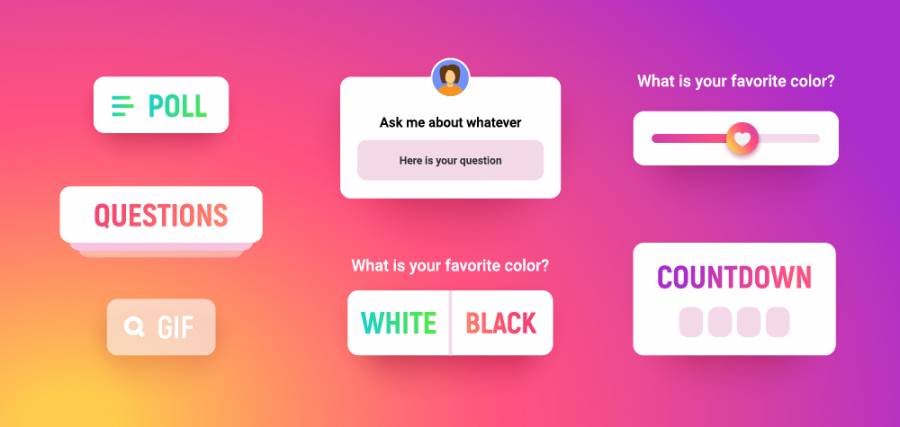Are you facing the YouTube vs. Instagram influencers dilemma and not sure which is better for your business?
Don’t worry, you’re not alone. It’s a difficult choice because both platforms are great for influencer marketing and have substantial user bases.
As per Statista, YouTube and Instagram rank second and third respectively, in terms of the number of monthly users.
 Image via Statista
Image via Statista
Both offer exceptional engagement and entertainment to the millions of users who log into these social networks every day.
And both these platforms have become extremely popular for influencer marketing.
But which platform should you choose for your campaigns? Which is a better choice for you: YouTube vs. Instagram influencers?
To start, we’ll provide you with an overview of both YouTube and Instagram, what makes them unique and what sets them apart.
Read on to understand which platform will serve your influencer marketing goals better.
Table of Contents
YouTube vs. Instagram: Key Statistics and Features
Before we go on to compare YouTube vs. Instagram influencers, let us look at a few key statistics for each platform.
YouTube
- The 2nd most popular social media channel in the world with more than 2.5 billion active users.
- People spend an average of 28 hours and 5 minutes on YouTube, every month.
 Image via DataReportal
Image via DataReportal
YouTube certainly is the best option for brands that want influencers to create in-depth content to promote or review their products or services.
You can share highly engaging long-form and short-form videos to offer your potential customers a comprehensive overview of who you are, what you have to offer, and how you stand out.
It’s easier to lead your customers to purchase by providing a link in the description too.
This makes YouTube perfect for product videos like explainer videos or detailed reviews.
- It is the 3rd most popular social media channel with nearly 2 billion active users.
- The average monthly time spent on Instagram is 15 hours and 50 minutes, which is lower than that spent on YouTube.
Instagram, as an influencer marketing platform, is a great hit with both users and marketers because of the enormous amount of fresh content that is available on the platform. Brands can collaborate with influencers and repost the content easily.
Content on Instagram is effortlessly consumed by the users too. It’s easier to edit campaigns on the go and insights are readily available as well.
Key Differences Between YouTube and Instagram Influencer Marketing
Here are some of the major differences between YouTube and Instagram influencer marketing that you should know.
1. Long-Form Videos vs. Short-Form Media
The predominant difference between YouTube and Instagram is the kind of content each platform offers.
When it comes to influencer marketing on YouTube, it’s exclusively about videos. The audience here is treated to long-form, horizontal videos which are created and edited professionally.
This makes it perfect for product review videos and other videos that provide in-depth information about a brand or its products.
Take a look at Dude Perfect’s profile, one of the leading YouTube influencers, who constantly churns out long-form videos that garner millions of views.

Image via YouTube
Instagram is more versatile than YouTube, as it supports both images and videos, including short-form and long-form videos. However, the video length is higher on YouTube than on Instagram.
Creators here go to great lengths to produce fresh and engaging content every day. The best part about Instagram is that it’s got something for everyone.
So, if you’re looking for influencers who are experts at short-form videos or image creation, you should opt for Instagram influencers. Otherwise, it’s a good bet to partner with YouTube influencers.
2. Post Searchability
When comparing YouTube vs. Instagram influencers, YouTubers have a greater responsibility to produce videos that stay relevant not only for days but for years. They need to be search-friendly too. This requires a mix of video-making and SEO skills.
It’s not the same case with Instagram, though. The feed is constantly updated with fresh content and users hardly search for older posts.
The advantage of YouTube videos is that the video links and descriptions are indexed on Google. When users search for information on Google, relevant YouTube videos will appear in the search results like below.
 Image via Google
Image via Google
Instagram content can only be searched within the Instagram app and it’s not very easily found on Google. One of the easier ways to search for relevant content on Instagram is by using hashtags. So, it’s important to check if your influencers are getting their hashtags right.
3. Cost-Effective vs. Valuable
One of the key factors to consider while choosing between YouTube vs. Instagram influencers is the cost. Generally, Instagram brand ambassadors and influencers are more cost-effective.
The reason?
Creating image-based posts is easier than producing long-form videos. This makes Instagram influencers a lot more affordable when compared to YouTube influencers.
But that doesn’t mean YouTube influencers are no good.
Yes, YouTube influencers charge more than Instagram influencers, but when you want the influencer to dive deep into your product, there’s no better place than YouTube.
YouTubers tend to invest more effort and time in creating long-form video content that can remain relevant for a long time. They also have to make the content SEO friendly. It’s thus no surprise how much sponsors pay YouTubers.
Also, a tactic that marketers use to make YouTube campaigns more affordable is to ask creators for short 30-to-90-second video integrations instead of long-form dedicated videos.
Video integrations can be purchased for a fraction of the price of a dedicated video on YouTube. Integrations are a way to reach a large audience on YouTube without breaking the bank.
4. Creative Bandwidth
Let’s admit it, Instagram’s filters and adjustments to enhance images visually are simply superb. These built-in features allow you to beautify your images and videos on the go. Amature photographers can add a professional touch to their captures using these quickly accessible filters.
On the contrary, you need some pro skills to edit a standard YouTube video. YouTube influencers not only need to use high-end equipment to record their videos but also have to use sophisticated editing tools to give their videos a professional touch.
This means that YouTubers need more time, skills, and money to execute influencer marketing campaigns effectively. And that matters a lot when you are selecting between YouTube vs. Instagram influencers.
5. Social Commerce Features
YouTube vs. Instagram influencers: who can lead your potential customers to in-app purchases? The answer used to be Instagram, but now YouTube is not far behind.
Instagram supports product carousel display and the users can make a purchase by clicking the link. Additionally, Instagram also offers the shoppable posts feature through which you can buy a product displayed in a post directly from the platform.
Instagram’s social commerce features are more effective because you can offer discounts, special offers, and deals directly through the app.
Now, let’s consider the social commerce options available on YouTube.
YouTube influencers can provide purchase links in the video description, which is an effective way of boosting traffic to client websites.
Moreover, many YouTubers share unique discount codes with their audience, which are great for boosting your sales conversion rate.
In recent years, YouTube has also launched some social commerce features to bring it more head-to-head with Instagram.
Influencers can, for instance, tag products they’re promoting in YouTube Shorts. They can even link to a “Shop” where their audience can check out multiple products. This is similar to Instagram “link in bio” shops.
Check out this YouTube Short where the YouTuber has added a link to their shop. People can click on it and check out the various products that the YouTuber promotes.
 Image via YouTube
Image via YouTube
6. Types of Sponsored Content
YouTube and Instagram influencers post different kinds of sponsored content for brands. Let’s check out what each has to offer.
Influencers on Instagram promote brands in many ways, such as:
- Brand or product mentions
- Sponsored posts
- Brief product reviews of gifted products
- Instagram Stories or Reels with CTA links
- Giveaways or contests, co-hosted with a brand
- Account takeovers
Some examples of sponsored content that YouTube influencers share include:
- In-depth product reviews, unboxing videos, or haul videos
- Product insertions or placements within native video content
- Affiliate marketing where YouTube influencers share product links in descriptions
- Product tutorials, explainer videos, and how-to videos
These are, of course, not comprehensive lists. YouTube and Instagram influencers can do a lot more. This just gives you an idea of what kind of content you can expect from YouTube and Instagram influencers, in general.
YouTube vs. Instagram Influencers: What to Consider When Choosing?
Choosing between YouTube vs. Instagram influencers is not easy. There are several factors to consider when making this choice.
Here, we’ll discuss some of the most important factors you should consider when choosing between YouTube vs. Instagram influencers.
Audience Presence
Where does your target audience exist in greater numbers and which one is their favorite social platform? This understanding makes it easy for you to not only choose between YouTube vs. Instagram influencers but also craft the right kind of campaign.
Start by understanding and defining your target audience and then check the audience demographics of each platform to assess where they are most active.
Choice of Media
When you identify your target audience, it is imperative to understand their preferences too. Do they resonate more with long-form videos or short videos and images?
The success of your influencer marketing campaign depends heavily on this understanding. Choose the wrong platform and you might miss the mark by a mile.
To cut the story short: choose YouTube influencers if you want long-form video content and Instagram influencers for aesthetic posts and reels.
Budget
You should consider the influencer marketing cost on both platforms. While choosing between YouTube vs. Instagram influencers research the market to determine which platform fits better into your budget while helping you reach your goals effectively.
Generally, YouTube influencers charge more than Instagram influencers because they put more time and effort into creating in-depth videos. However, the influencer rates vary by industry and other factors, across both platforms.
Content Reach and Visibility
One important thing to consider when choosing between YouTube vs. Instagram for influencer marketing is content reach.
How easy is it to share the content on other platforms? Can people discover your content via search engines or is it only available on the platform?
In this YouTube vs. Instagram comparison, the former is a clear winner.
YouTube videos are easy to share across platforms and you can even embed these on your website. This means you can get the most out of your influencer content and share it across multiple platforms.
Moreover, YouTube videos rank for relevant search queries on Google. When someone types a search query on Google, sometimes YouTube videos feature on top, even before other search results.
This means that the content YouTube influencers create for your brand has a much wider reach and online visibility than Instagram content.
What does this mean for your influencer marketing strategy?
If you want to create evergreen content that generates organic traffic for years, collaborate with YouTube influencers.
However, if you want to run a short-term campaign to promote a new product, for instance, work with Instagram influencers.
Industry Relevance
Some industries like travel, fashion, and beauty are popular on both channels. However, there are some types of influencers that prefer one channel over the other.
Any industry that requires sharing aesthetic product pictures for promotions would benefit from Instagram influencer marketing. This includes practical all consumer products niches.
However, if you’re in a niche where you need to create educational content about your products, then YouTube is better. Some examples include new and innovative technology products or SaaS solutions.
That said, Instagram is better for B2B businesses while YouTube is a better choice for most B2B businesses.
Depth of Content
Lastly, your choice between YouTube vs. Instagram influencers comes down to a simple fact: how in-depth content you want influencers to create.
Let’s say, you have a travel-related business, hotels for example. Both Instagram and YouTube influencers are equally relevant for your business. You also have the budget to spend on influencer marketing, irrespective of the channel.
You need to decide what kind of content you want influencers to share. Do you want them to visit your property and post aesthetic pictures and Instagram Stories? Instagram is perfect for that.
Or do you want influencers to create a useful video helping travelers choose the right accommodation and insert your property as the top option? This is a more subtle way of promoting your hotels and more contextual. YouTube influencers are perfect for this kind of content.
You can, of course, work with both YouTube and Instagram influencers to create a variety of content and cross-promote it across channels. If you have the budget for it, using both platforms and different influencers will give you the best results.
FAQs
1. Is YouTube or Instagram more popular?
Both social media platforms rank among the most popular ones. While YouTube boasts of having more total users, Instagram has over two billion active users as well.
As a marketer, you can consider either of these popular platforms based on your target audience and the kind of campaign you want to run.
Generally, Instagram is more popular among B2B marketers who want to share aesthetic product pictures. YouTube, on the other hand, is more popular among marketers that like sharing in-depth education content to win customers.
2. Can YouTubers be influencers?
Absolutely. YouTubers are great at creating engaging videos, writing targeted content, editing, engaging with followers, and managing their community. Not only are they experts in their niche but equally good at connecting with their followers.
Since YouTubers engage their viewers for longer, they’re able to build much deeper audience connections than Instagram influencers. Their audiences trust their recommendations, which makes them great influencers.
3. Is it worth becoming an Instagram influencer?
It is totally worth becoming an Instagram influencer, but the road to success is not an easy one. You have the responsibility of constantly offering fresh and engaging content to your followers, maintaining a brand reputation, and keeping up with the competition to stand out.
Gaining followers on Instagram is not easy and keeping them engaged is even more difficult. You need to consistently and frequently post relevant content to achieve that, which can be tough.
However, if you can keep up with its demands, it’s a great influencer marketing channel, preferred by many brands.
4. How much should I pay a YouTube influencer?
There are several factors that determine how much a YouTube influencer should be paid. The size of their following, the kind of influencer campaign you are running, and campaign goals should be considered while deciding on the payment.
The rates vary considerably from influencer to influencer and can range from $10 to thousands of dollars.
5. How do you choose between YouTube vs. Instagram influencers?
Choosing between YouTube vs. Instagram influencers can be a big dilemma considering the fact that both social platforms have their own advantages. When you have to make this crucial decision, keep these 4 factors in mind:
- Audience presence – On which platform are your potential customers more active?
- Resonance – Do your audiences resonate with a pure video platform or an image/short-video one?
- Relevance – Which platform is more relevant to your brand and products?
- Budget – Which platform is more cost-friendly for your social media influencer campaign?
- Content reach – Do you want to attract organic traffic from search engines or are content with attracting just the platform’s users?
- Industry – Which platform is better for your niche and where can you find the best influencers within your niche?
- Content Depth – Do you want influencers to create in-depth, educational content or share aesthetic images and short videos?
Make the Right Choice Between YouTube vs. Instagram Influencers
YouTube and Instagram both are promising platforms and have a wealth of prominent influencers.
Both platforms are exceptional in their own way and it’s hard to choose one over the other. That said, you can select either one of them based on the kind of campaign you are planning.
However, make sure that the influencer you select is relevant to your brand and has an audience that’s similar to that of your brand. They must also suit your marketing budget.
And if you’re looking for professional support to design and execute your influencer campaign, click here to get in touch with our team and see what we can achieve together.



